-
PESQUISA01/01/2018
Impact of anxiety and depression on morbidity and mortality of patients with coronary syndrome
Revista Brasileira de Enfermagem. 2018;71(6):3048-3053
Resumen
PESQUISAImpact of anxiety and depression on morbidity and mortality of patients with coronary syndrome
Revista Brasileira de Enfermagem. 2018;71(6):3048-3053
DOI 10.1590/0034-7167-2017-0709
Visualizações0Ver maisABSTRACT
Objective:
Evaluate the impact of anxiety and depression on morbidity and mortality of patients with acute coronary syndrome.
Method:
Retrospective cohort study, with follow-up of two years, conducted with 94 patients. The morbidity and mortality (readmission, myocardial revascularization, and death) was evaluated immediately after discharge and after one and two years. Anxiety and depression were evaluated by the State-Trait Anxiety Inventory and by Beck’s Depression Inventory. The Kaplan-Meier estimator and the Logrank test were used. The significance level adopted was 0.05.
Results:
We observed that 76.6% of the patients did not present symptoms of depression or had mild signs, while 78.8% had low to moderate anxiety. The symptoms of depression and anxiety were not related to morbidity (need for MR p=0.098 and 0.56, respectively; readmission p=0.962 and 0.369, respectively) and mortality (p=0.434 and 0.077, respectively).
Conclusion:
No relationship was found between levels of anxiety and depression with the morbidity and mortality of patients.
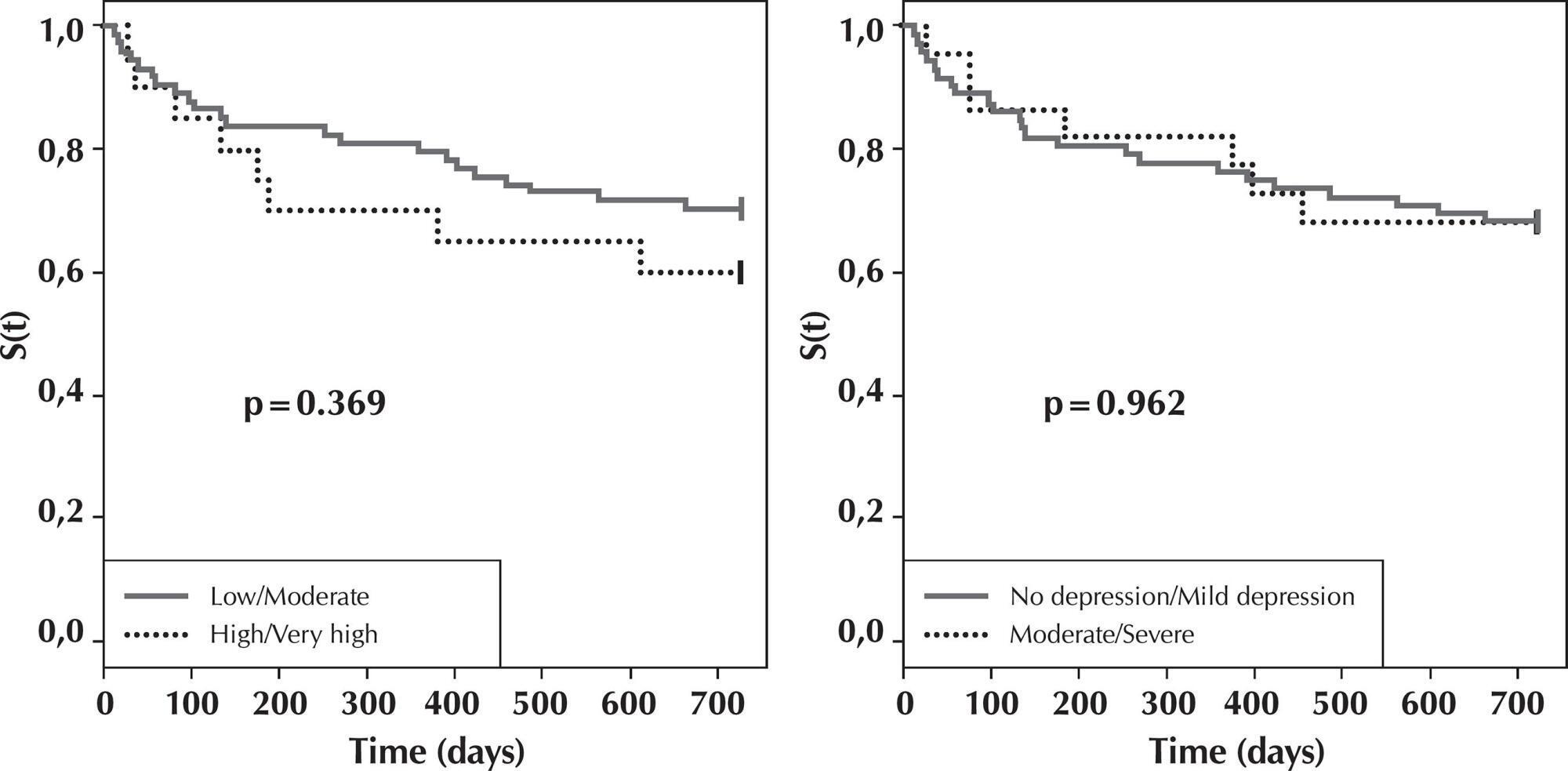
-
PESQUISA01/01/2018
Degree of risk for foot ulcer due to diabetes: nursing assessment
Revista Brasileira de Enfermagem. 2018;71(6):3041-3047
Resumen
PESQUISADegree of risk for foot ulcer due to diabetes: nursing assessment
Revista Brasileira de Enfermagem. 2018;71(6):3041-3047
DOI 10.1590/0034-7167-2017-0189
Visualizações0Ver maisABSTRACT
Objective:
To classify the level of risk for foot ulcers in people with diabetes mellitus and identify their main predictive risk factors.
Method:
Exploratory, descriptive study, in which patients were assessed in a municipal ambulatory of São Paulo through nursing consultation, following the guidelines of the International Consensus on the Diabetic Foot. Data were descriptively analyzed.
Results:
The analyzed population was composed of 50 longevous and retired people, with household income of up to two minimum wages, with dermato-neurofunctional risk factors and unfavorable clinical indicators, and 66% had Risk 1; 16% Risk 2; 6% Risk 3 and 12% Risk 4. Of this analyzed total, 96% never had their feet examined with the Semmes-Weinstein monofilament.
Conclusion:
The data found indicate the importance of careful feet examination in people with diabetes by the nursing staff to identify future risks of ulcers and, thus, prevent them.
-
PESQUISA01/01/2018
Alarm fatigue and the implications for patient safety
Revista Brasileira de Enfermagem. 2018;71(6):3035-3040
Resumen
PESQUISAAlarm fatigue and the implications for patient safety
Revista Brasileira de Enfermagem. 2018;71(6):3035-3040
DOI 10.1590/0034-7167-2017-0481
Visualizações0Ver maisABSTRACT
Objective:
To measure the response time of health professionals before sound alarm activation and the implications for patient safety.
Method:
This is a quantitative and observational research conducted in an Adult Intensive Care Unit of a teaching hospital. Three researchers conducted non-participant observations for seven hours. Data collection occurred simultaneously in 20 beds during the morning shift. When listening the alarm activation, the researchers turned on the stopwatches and recorded the motive, the response time and the professional conduct. During collection, the unit had 90% of beds occupied and teams were complete.
Result:
We verified that from the 103 equipment activated, 66.03% of alarms fatigued. Nursing was the professional category that most provided care (31.06%) and the multi-parameter monitor was the device that alarmed the most (66.09%).
Conclusion:
Results corroborate the absence or delay of the response of teams, suggesting that relevant alarms might have been underestimated, compromising patient safety.
-
PESQUISA01/01/2018
Pressure Ulcer in Intensive Care Units: a case-control study
Revista Brasileira de Enfermagem. 2018;71(6):3027-3034
Resumen
PESQUISAPressure Ulcer in Intensive Care Units: a case-control study
Revista Brasileira de Enfermagem. 2018;71(6):3027-3034
DOI 10.1590/0034-7167-2017-0950
Visualizações0Ver maisABSTRACT
Objective:
To evaluate the relationship between presence/absence of Pressure Ulcer, socio-demographic factors and hospitalization.
Method:
Case-control study, performed through multiple logistic regression based on information from the adverse event reporting system and the hospital information system, between September/2014 and August/2015.
Results:
Among the risk factors, after adjustment, age greater than or equal to 60 years, hospitalization due to infectious, parasitic and neoplastic diseases, periods of hospitalization longer than seven days and being hospitalized in ICU other than ICU covenant were highlighted. Most of ulcers were reported with mild damage degree and Stage II classification.
Conclusion:
Age and days of hospitalization presented a dose-response effect, the longer the age or the number of days of hospitalization, the greater the chances of Pressure Ulcer. There was a significant association among higher occurrences of death in patients with ulcer.
-
PESQUISA01/01/2018
Creation and validation of a checklist for blood transfusion in children
Revista Brasileira de Enfermagem. 2018;71(6):3020-3026
Resumen
PESQUISACreation and validation of a checklist for blood transfusion in children
Revista Brasileira de Enfermagem. 2018;71(6):3020-3026
DOI 10.1590/0034-7167-2018-0098
Visualizações0Ver maisABSTRACT
Objective:
To describe the process for creating and validating a checklist for blood transfusion in children.
Method:
Methodological study, conducted from November 2016 to May 2017, developed in two stages. The content of the items that compose the instrument was based on scientific evidence and submitted to specialized nurses for content validation. We applied the Content Validity index, considering the value ≥ 0.80.
Results:
The content was considered valid with global CVI of 0.87. Suggestions for adjustments, such as deletion, replacement, and addition of terms, were included in the final version, which consisted of 14 items and 56 subitems.
Conclusion:
The checklist for blood transfusion in children was considered a technology with valid content to be used in the transfusion performed by nurses, thus contributing to transfusion safety in children.
-
PESQUISA01/01/2018
Influence of socio-demographic, clinical and surgical variables on the Aldrete-Kroulik Scoring System
Revista Brasileira de Enfermagem. 2018;71(6):3013-3019
Resumen
PESQUISAInfluence of socio-demographic, clinical and surgical variables on the Aldrete-Kroulik Scoring System
Revista Brasileira de Enfermagem. 2018;71(6):3013-3019
DOI 10.1590/0034-7167-2017-0813
Visualizações0Ver maisABSTRACT
Objective:
To identify the influence of the variables sex, age, type of anesthesia, occurrence of intraoperative complications, pain and surgical complexity on the Aldrete-Kroulik Scoring System in patients in the immediate postoperative period, in the post-anesthesia care unit.
Method:
Non-experimental, longitudinal study, with a quantitative approach, conducted with 241 surgical patients. Descriptive analysis, Student’s t-test, Pearson and Spearman Correlation Indexes and multiple linear regression were used to analyze the data.
Results:
Correlations between the Aldrete-Kroulik Scoring System and pain (r=-0.13; p=0.05) and surgical complexity (r=-0.12; p=0.05) were statistically significant. The type of anesthesia and pain (p<0.01) influenced the decrease of the Aldrete-Kroulik System’s scores.
Conclusion:
Considering the vulnerability of patients in the immediate postoperative period, it is essential for the nurse to know the factors that can influence the Aldrete-Kroulik Scoring System to provide a safe and optimal post-anesthesia recovery.
-
PESQUISA01/01/2018
Association between follow-up in health services and antihypertensive medication adherence
Revista Brasileira de Enfermagem. 2018;71(6):3006-3012
Resumen
PESQUISAAssociation between follow-up in health services and antihypertensive medication adherence
Revista Brasileira de Enfermagem. 2018;71(6):3006-3012
DOI 10.1590/0034-7167-2018-0087
Visualizações0Ver maisABSTRACT
Objective:
To analyze the association between the characteristics of follow-up in health services and adherence to antihypertensive medication in patients with cardiovascular disease.
Method:
Analytical study carried out with 270 patients suffering from hypertension and hospitalized due to cardiovascular complications. Data collection occurred between November 2015 and April 2016, involving sociodemographic variables, presence of self-reported diabetes, accessibility and use of health services, blood pressure levels and medication adherence (analyzed through the Morisky–Green Test).
Results:
The rate of adherence to antihypertensive therapy was 63.0%. Enrollment in the Hiperdia program had no statistical significance to medication adherence. People who attended at least between 4 and 6 nursing consultations throughout the data collection period (p = 0.02) had better adherence.
Conclusion:
The study’s findings provide support for the reorientation of health services and their public policies towards improving adherence to antihypertensive therapeutics.
-
PESQUISA01/01/2018
Cross-cultural adaptation of the General Comfort Questionnaire to Brazilian patients with myocardial infarction
Revista Brasileira de Enfermagem. 2018;71(6):2998-3005
Resumen
PESQUISACross-cultural adaptation of the General Comfort Questionnaire to Brazilian patients with myocardial infarction
Revista Brasileira de Enfermagem. 2018;71(6):2998-3005
DOI 10.1590/0034-7167-2017-0557
Visualizações0Ver maisABSTRACT
Objective:
Describe the first stages of the cross-cultural adaptation process of the General Comfort Questionnaire for myocardial infarction patients in intensive care units.
Method:
This is a study of qualitative and quantitative research and analysis techniques. Conceptual, item, semantic and operational equivalence was performed. Fifteen items were added to the original instrument to better represent the comfort experienced by myocardial infarction patients in intensive care units. The content validity index was applied to analyze the answers of the experts; it was considered adequate above 0.78.
Results:
Some changes suggested by the experts for better understanding were adopted. All items were kept, obtaining a scale of sixty-three items. In the pre-test conducted with 30 subjects, the instrument was considered adequate to the target audience.
Conclusion:
The adapted version of the General Comfort Questionnaire for people with myocardial infarction is adequate to the target audience.

-
14/04/2021
Child behavior during the social distancing in the COVID-19 pandemic
Revista Brasileira de Enfermagem. 2021;74:e20200762
Resumen
Child behavior during the social distancing in the COVID-19 pandemic
Revista Brasileira de Enfermagem. 2021;74:e20200762
DOI 10.1590/0034-7167-2020-0762
Visualizações0Ver maisABSTRACT
Objective:
To describe the daily activities performed by children from 6 to 12 years of age incomplete and analyze children’s behavior during social distancing in the face of the COVID-19 pandemic.
Methods:
Cross-sectional study with children in a learning stage living in Brazil. The data were collected via online form. Fisher’s exact test was applied to analyze the association of categorical variables with child behavior; when significant, it was used the odds ratio. It was considered results considered statistically significant those presenting values of p < 0.05.
Results:
Data from 530 children were analyzed: 50.3% female, 71.3% from the Southeast Region, 73% in fulltime social distancing, 52% presented anxiety, which was significantly associated with changes in sleep and appetite.
Conclusion:
The results indicate the need for parents/caretakers to stimulate moments for the child to express themselves, not minimizing their feelings and providing emotional support to mitigate the negative impact of these feelings on the child’s mental and physical health.
-
05/12/2019
Hospital care and urinary incontinence in the elderly
Revista Brasileira de Enfermagem. 2019;72:284-293
Resumen
Hospital care and urinary incontinence in the elderly
Revista Brasileira de Enfermagem. 2019;72:284-293
DOI 10.1590/0034-7167-2018-0273
Visualizações0Ver maisABSTRACT
Objective:
to identify factors inherent in hospital care that favor urinary incontinence in the elderly.
Method:
an integrative review with Scopus, CINAHL and Pubmed searches. Includes original articles, no language restriction, published between 2008 and 2018. Rated level of recommendation and level of evidence were assessed using the Oxford Center for Evidence-Based Medicine classification. Exploited content through thematic analysis in light of the Donabedian model.
Results:
13 articles constituted the sample. There were factors such as the unjustified and indiscriminate use of devices such as the geriatric diaper; hospital structure adversely affecting the needs of the elderly; and deficit in screening, risk identification and underreporting of the problem favor urinary incontinence in the hospitalized elderly.
Conclusion:
modifiable factors related to hospital structures and care processes favor both the onset and worsening of urinary incontinence in the elderly.
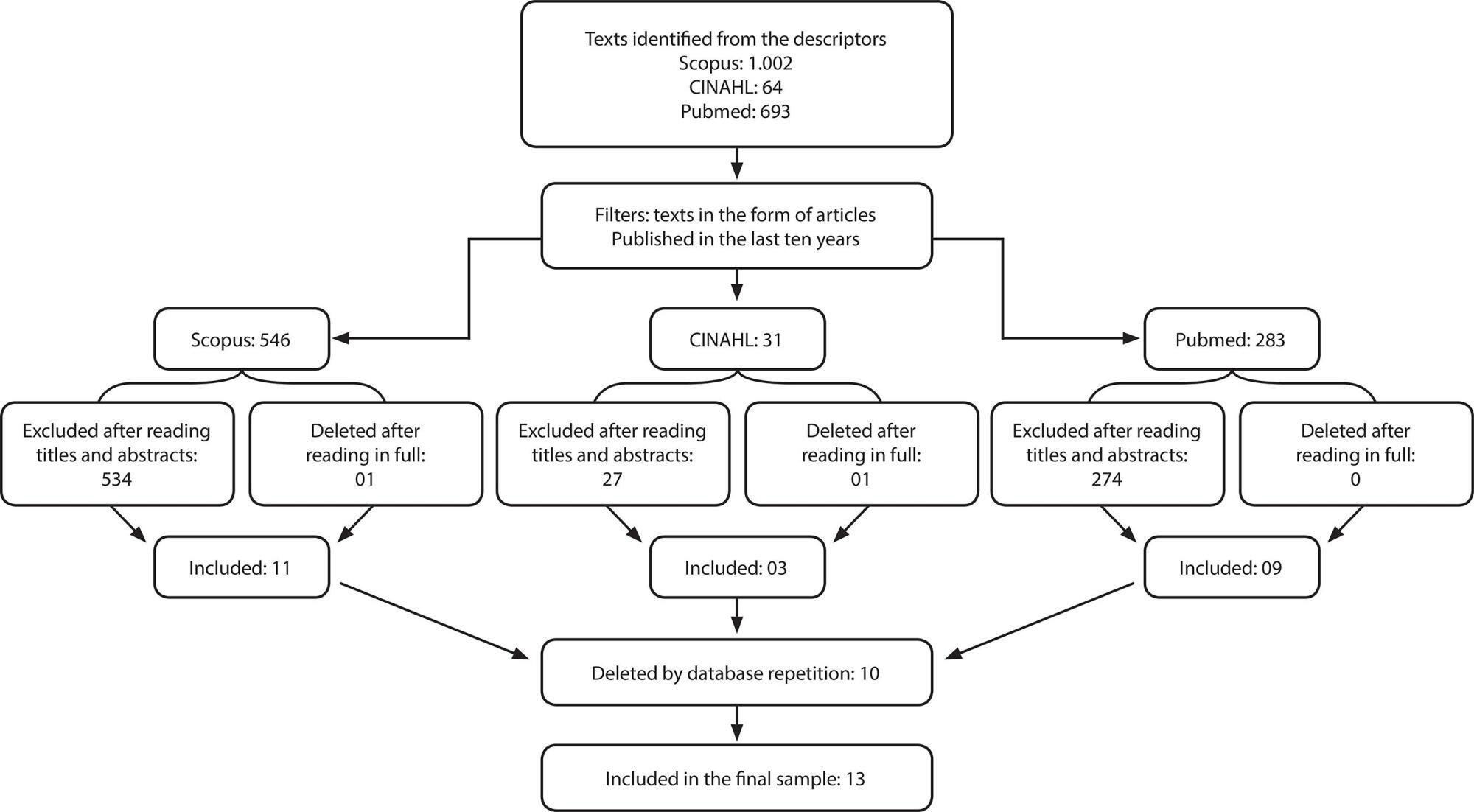
-
ARTÍCULO ORIGINAL21/10/2019
Hipermídia educativa sobre assistência de enfermagem ao parto: construção e validação de conteúdo e aparência
Revista Brasileira de Enfermagem. 2019;72(6):1471-1478
Resumen
ARTÍCULO ORIGINALHipermídia educativa sobre assistência de enfermagem ao parto: construção e validação de conteúdo e aparência
Revista Brasileira de Enfermagem. 2019;72(6):1471-1478
DOI 10.1590/0034-7167/2018-0163
Visualizações1Ver maisRESUMO
Objetivo:
construir uma hipermídia educativa sobre a assistência de enfermagem ao parto de risco habitual e realizar a validação de conteúdo e de aparência.
Método:
pesquisa metodológica, realizada seguindo as seguintes etapas: levantamento do conteúdo e planejamento dos módulos; produção das mídias e organização das unidades tutoriais; organização do espaço do aluno, tutor e de comunicação entre eles; elaboração da hipermídia; disponibilização da hipermídia; avaliação por especialistas em Enfermagem e Informática; e implementação das sugestões propostas.
Resultados:
a hipermídia educativa mostrou-se como um material validado, visto que apresentou um ótimo índice de validade de conteúdo global de 0,97 e significância estatística no teste binomial para o conteúdo e aparência.
Conclusão:
acredita-se que o uso deste material com alunos da graduação em Enfermagem contribuirá com a qualidade da assistência obstétrica, tendo em vista que se constitui em uma tecnologia ilustrada capaz de favorecer o ensino-aprendizagem sobre parto normal humanizado.
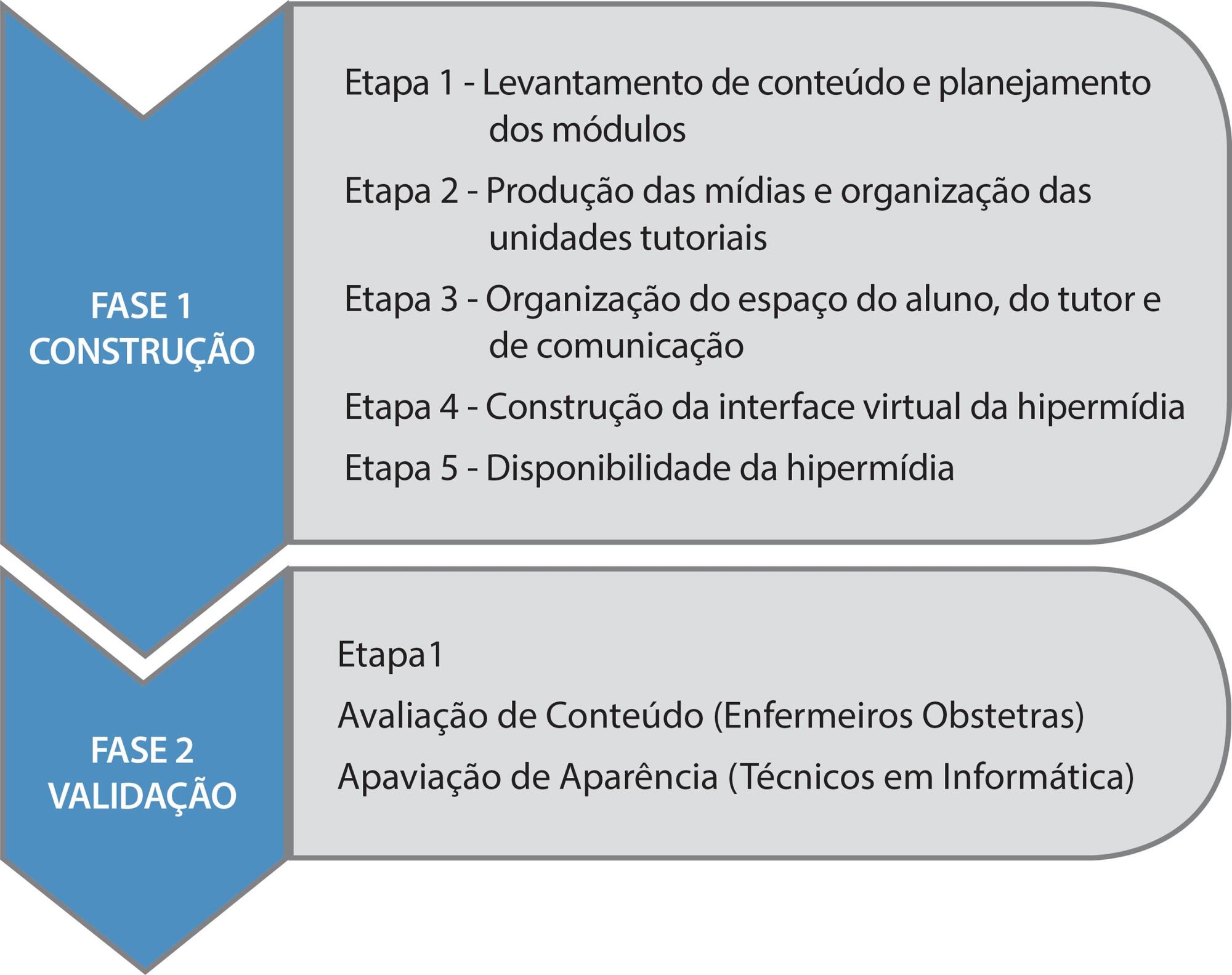
-
ARTÍCULO ORIGINAL30/03/2020
Boas Práticas de segurança nos cuidados de enfermagem em Terapia Intensiva Neonatal
Revista Brasileira de Enfermagem. 2020;73(2):e20180482
Resumen
ARTÍCULO ORIGINALBoas Práticas de segurança nos cuidados de enfermagem em Terapia Intensiva Neonatal
Revista Brasileira de Enfermagem. 2020;73(2):e20180482
DOI 10.1590/0034-7167-2018-0482
Visualizações0RESUMO
Objetivos:
identificar a percepção dos profissionais de enfermagem sobre o erro humano nos cuidados de enfermagem na Unidade de Terapia Intensiva Neonatal; analisar as estratégias de Boas Práticas propostas por esses profissionais para a segurança do paciente nos cuidados de enfermagem.
Métodos:
estudo quanti-qualitativo, descritivo. Cenário: Unidade de Terapia Intensiva Neonatal. Participantes: 22 profissionais de enfermagem. Coleta dos dados realizada por meio de entrevistas e submetidos a análise temática.
Resultados:
erro humano nos cuidados de enfermagem, identificando-se perdas de cateteres e erros no processo de medicação; causas para o erro nos cuidados de enfermagem, destacando-se a sobrecarga de trabalho; Boas Práticas para a segurança do paciente nos cuidados de enfermagem, como capacitação profissional e melhorias das condições de trabalho.
Conclusões:
demonstra-se a importância de investir em estratégias de Boas Práticas para a Segurança do Paciente, buscando-se sedimentar a cultura de segurança organizacional e estimular um ambiente propício ao gerenciamento do erro.
Palavras-chave: EnfermagemErros MédicosGestão de SegurançaSegurança do PacienteUnidades de Terapia Intensiva NeonatalVer mais -
ARTÍCULO DE REVISIÓN29/09/2022
Nursing students’ learning from involvement in research projects: an integrative literature review
Revista Brasileira de Enfermagem. 2022;75(1):e20210053
Resumen
ARTÍCULO DE REVISIÓNNursing students’ learning from involvement in research projects: an integrative literature review
Revista Brasileira de Enfermagem. 2022;75(1):e20210053
DOI 10.1590/0034-7167-2021-0053
Visualizações0Ver maisABSTRACT
Objective:
To identify the learning outcomes and skills obtained of undergraduate nursing students involved in research projects.
Methods:
This was an integrative literature review, based on a research protocol in the CINAHL Complete databases; Cochrane Central Register of Controlled Trials; Cochrane Database of Systematic Reviews; Cochrane Methodology Register; MedicLatina; MEDLINE, Scopus and JBI, including primary and secondary studies, published between 2015 and 2020.
Results:
A total of five heterogeneous articles were included, which were categorized using Kirkpatrick’s (adapted) model. Seventeen learning outcomes acquired through participation in research projects were identified, from the learning of new knowledge and skills to the development of new attitudes and behaviors.
Final considerations:
The involvement of nursing students in research projects is important to their professional development. Future investment in research on this topic can help cement the potential of this type of student involvement.
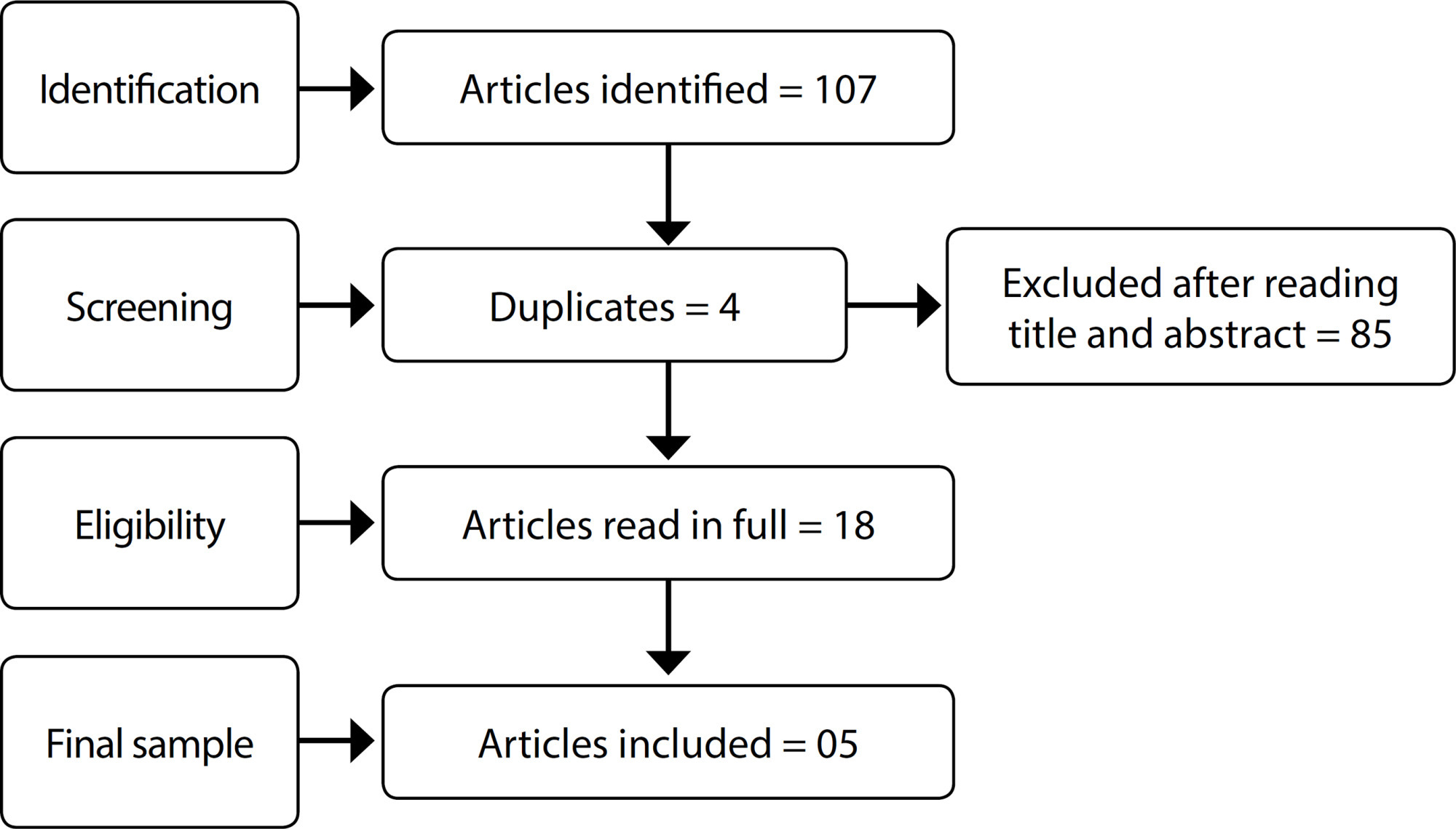
-
ARTÍCULO ORIGINAL05/12/2019
Qualidade de vida relacionada à saúde em pacientes com insuficiência cardíaca
Revista Brasileira de Enfermagem. 2019;72:140-146
Resumen
ARTÍCULO ORIGINALQualidade de vida relacionada à saúde em pacientes com insuficiência cardíaca
Revista Brasileira de Enfermagem. 2019;72:140-146
DOI 10.1590/0034-7167-2018-0368
Visualizações1RESUMO
Objetivo:
Avaliar a qualidade de vida relacionada à saúde dos pacientes com insuficiência cardíaca e relacionar aos dados sociodemográficos e clínicos.
Método:
Trata-se de estudo observacional, de corte transversal, com abordagem quantitativa realizado em ambulatório de insuficiência cardíaca no estado de Pernambuco.
Resultados:
Na amostra (n=101) houve predominância de homens, maiores de 60 anos, casados, profissionalmente inativos. A qualidade de vida relacionada à saúde, a partir do questionário Minnesota Living With Heart Failure Questionnaire foi considerada moderada (34,3±21,6), apresentando relação significativa com idade (p=0,004), classe funcional (p<0,001) e em pacientes com cardiopatia chagásica (p=0,02).
Conclusão:
A qualidade de vida no grupo IC de etiologia chagásica esteve mais comprometida, especialmente na dimensão emocional. Sugere-se a realização de estudos abordando as hipóteses de que maior tempo de acompanhamento ambulatorial melhora a qualidade de vida e que ter doença de Chagas interfere negativamente na qualidade de vida de pacientes com insuficiência cardíaca.
Palavras-chave: Assistência AmbulatorialDoença de ChagasEnfermagemInsuficiência CardíacaQualidade de VidaVer mais -
ARTÍCULO DE REVISIÓN21/12/2020
Aplicação da metodologia Lean Seis Sigma nos cenários de assistência à saúde: revisão integrativa
Revista Brasileira de Enfermagem. 2020;73:e20190861
Resumen
ARTÍCULO DE REVISIÓNAplicação da metodologia Lean Seis Sigma nos cenários de assistência à saúde: revisão integrativa
Revista Brasileira de Enfermagem. 2020;73:e20190861
DOI 10.1590/0034-7167-2019-0861
Visualizações0RESUMO
Objetivo:
analisar a produção científica sobre os resultados da metodologia Lean Six Sigma nas instituições de assistência à saúde.
Métodos:
revisão integrativa da literatura, com a seguinte pergunta: quais são os resultados nas instituições de saúde com a utilização da metodologia Lean Six Sigma e Six Sigma? A busca foi realizada nas bases de dados MEDLINE, LILACS, BDENF, CINAHL, Web of Science e Scopus, sem recorte temporal.
Resultados:
foram incluídos 34 artigos, publicados entre 2005 e 2019, sendo 52,9% provenientes dos Estados Unidos da América. As melhorias mais comumente encontradas foram em instituições hospitalares e na perspectiva dos clientes e processos internos.
Conclusão:
a utilização da metodologia Lean Six Sigma se demonstrou eficaz nos diversos cenários de assistência à saúde, se destacando uma lacuna em sua aplicação quanto ao engajamento e capacitação de pessoas.
Palavras-chave: Administração em SaúdeAssistência à SaúdeControle de QualidadeGestão da Qualidade TotalMelhoria de QualidadeVer mais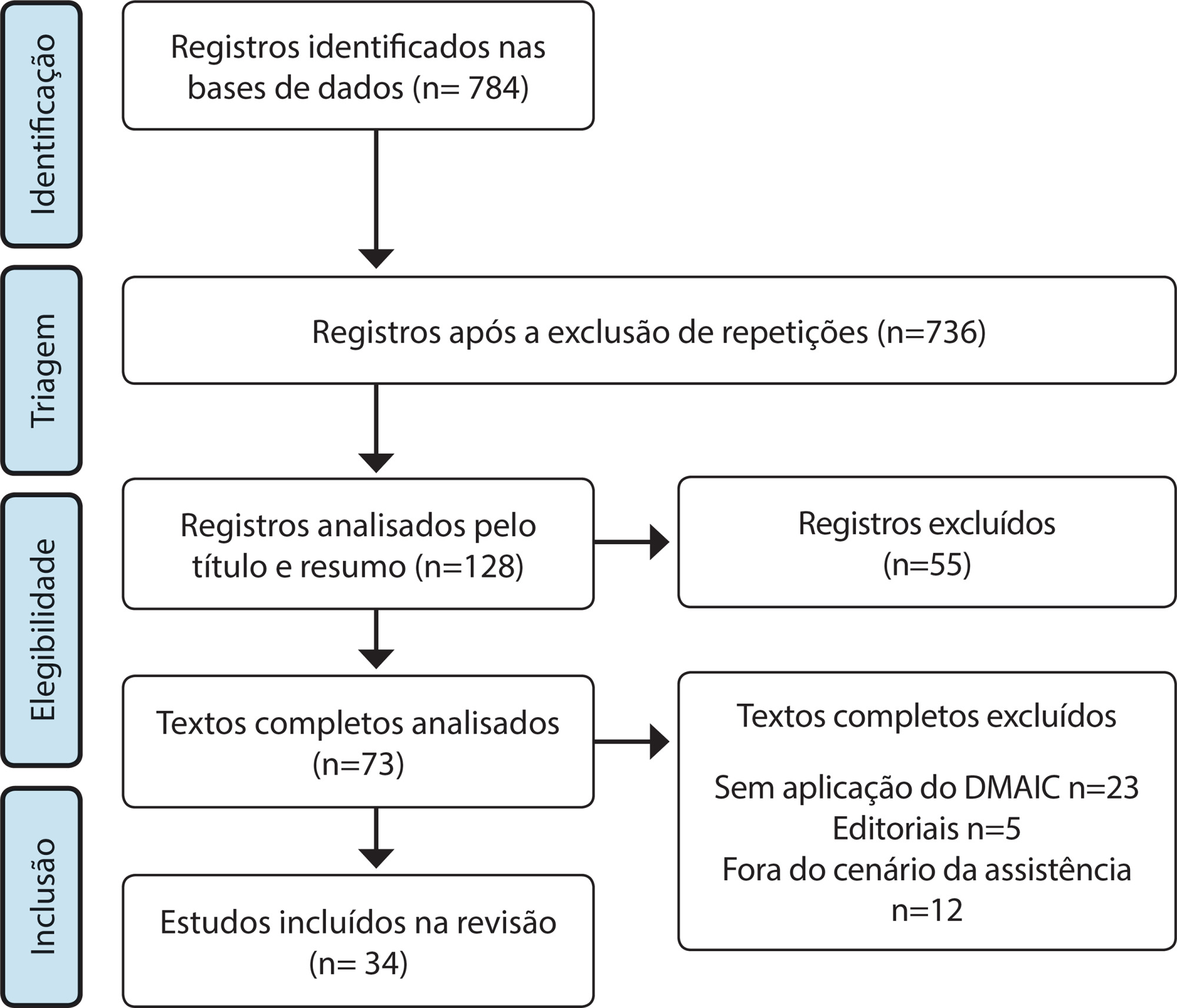
-
ARTÍCULO ORIGINAL17/02/2020
Análise dos registros de técnicos de enfermagem e enfermeiros em prontuários
Revista Brasileira de Enfermagem. 2020;73(2):e20180542
Resumen
ARTÍCULO ORIGINALAnálise dos registros de técnicos de enfermagem e enfermeiros em prontuários
Revista Brasileira de Enfermagem. 2020;73(2):e20180542
DOI 10.1590/0034-7167-2018-0542
Visualizações0RESUMO
Objetivos:
analisar as principais não conformidades dos registros de enfermagem de um hospital público do Nordeste na cidade de Natal.
Métodos:
estudo descritivo, transversal, abordagem quantitativa. Realizado em enfermarias médicas e cirúrgicas. Amostra composta de 120 prontuários de pacientes internados entre outubro e dezembro de 2016. Os dados obtidos foram tabulados e analisados por estatística simples em frequência absoluta e relativa com o software Microsoft Excel 2013. Para avaliar as não conformidades dos registros, usou-se o Diagrama de Pareto.
Resultados:
como principais problemas nos registros de enfermagem, destacou-se a ausência da categoria profissional e número do conselho, responsáveis por 41,8% das não conformidades nos registros de técnicos de enfermagem, enquanto nas anotações dos enfermeiros foram a ausência de hora e as letras ilegíveis, com 61,2%.
Conclusões:
o estudo evidenciou que os profissionais de enfermagem realizam seus registros de forma incompleta e que muitas vezes não documentam o cuidado prestado.
Palavras-chave: ComunicaçãoEnfermagemPesquisa sobre Serviços de SaúdeRegistros de EnfermagemSegurança do PacienteVer mais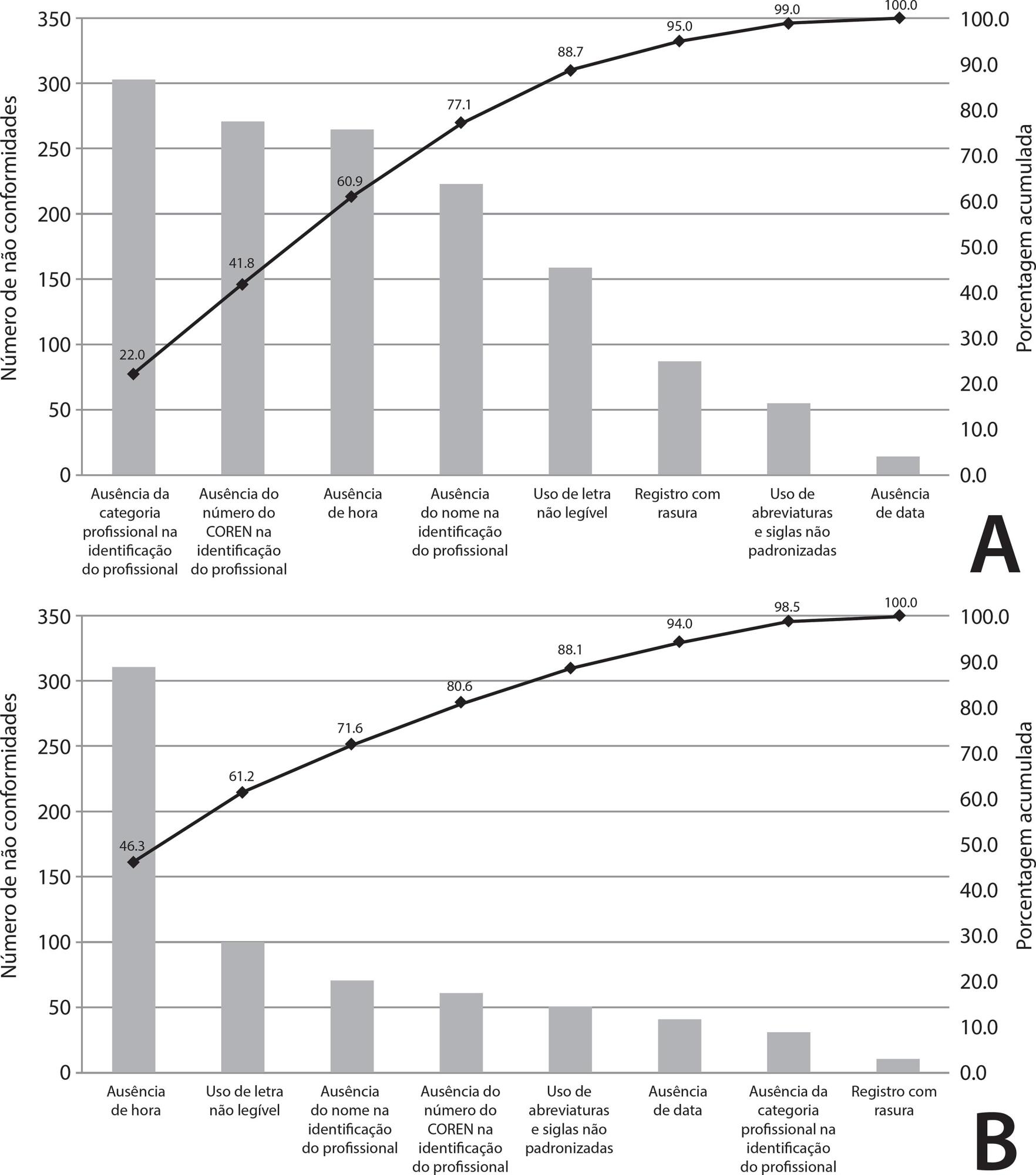
Búsqueda
Buscar en:
Nuvem de Tags
Adolescente (85) Atenção Primária à Saúde (239) COVID-19 (91) Criança (91) Cuidados de Enfermagem (269) Educação em Enfermagem (151) Educação em Saúde (139) Enfermagem (930) Enfermagem Pediátrica (86) Estudantes de Enfermagem (77) Estudos de Validação (131) Família (87) Idoso (208) Promoção da Saúde (99) Qualidade de Vida (104) Saúde do Trabalhador (86) Saúde Mental (145) Saúde Pública (82) Segurança do Paciente (150) Tecnologia Educacional (100)



